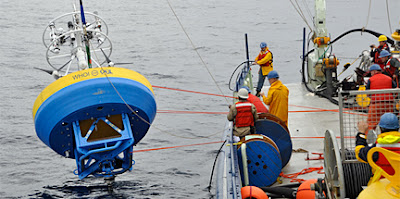After lots of excitement, Emma, Hilary and I have finally
arrived in Reykjavik, Iceland! We arrived Friday morning, and spent the day
resting and getting our bearings. One of the first things that Emma and I set
out to do was visit the Neil Armstrong, our home for the next 3 weeks. Seeing
it in Iceland is very exciting because the last time I saw it was back in Woods
Hole in January, when I was only dreaming about this research cruise. Now it is
here!
Emma and I in front of the R/V Neil Armstrong in Reykjavik's port. The top photo shows us near the middle of the ship's starboard side with the WHOI logo clearly visible, and the bottom photo shows us near the prow near the name "Neil Armstrong". Photos by Hilary Palevsky.
There are many things that our team prepared before heading
out to sea. Hilary previously shipped 12 boxes to Reykjavik that contained all
our scientific equipment. Today was spent unpacking the boxes, organizing our
materials, and setting up our various scientific equipment. Our three main
scientific stations were set up today: the Winkler Oxygen Titration station,
the underway flow-through system, and the filtering system. The Winkler Titration system is used to measure dissolved oxygen on samples of seawater, which we will eventually use to help calibrate OOI data. The
boat continuously pumps surface sea water onboard, and we are adding sensors to the ones already installed on the ship to
measure nitrate and dissolved oxygen. Nitrate is a key nutrient that plankton
need to grow, so knowing how much nitrate is present will help us to understand
the biology of the region. To calibrate the underway sensors, we will also
collect discrete seawater samples every six hours. Finally, we also set up a
filtering system to measure chlorophyll and particulate organic carbon. This
system works by pumping seawater through a filter attached to a flask. The filter
is put on the top of the flask and then a pump that pulls air out of the flask
is also attached. Manually, we will pour seawater into the filter and once
finished, fold up the filter paper, and store for later measurement.
Five of the boxes that Hilary shipped to Iceland in advance of our cruise.
A very important task before heading off to sea is making
sure that all equipment is secured in place before heading out. Using rope, zip
ties, and wall hooks, we secured all our equipment in place so that it does not
move around when we’re at sea. Space on the boat is in high demand, so we were
assigned our own area for science, and set up all of our equipment in our
little corner of the vessel. We will be sharing the rest of the lab with other
science folks and I’m eager to learn about the other research that will be
conducting aboard the Armstrong.
Tomorrow, we move into the boat, and on Tuesday we will depart
for the Irminger Sea! We first will head to the OOI Array site to deploy gliders, see if we can
recover a lost mooring from last year, and to deploy new moorings and recover
old moorings. Moorings are important oceanographic instruments because it
allows scientists to obtain continuous data about everything from salinity, to
dissolved oxygen to air-sea gas exchange. Moorings have a cable with an anchor
at one end and a float at the surface. Instruments are often placed along the
cable, so that scientists can obtain a better understanding of the entire water
column, rather than just the surface ocean. The moorings that we will deploy
are 3 km long! I can’t wait to see how they are deployed.
Until next time… Lucy




Let us know what the OOI that's been out there for a year looks like after you scrape off all the seagull poop (ahem, I meant to say "Seabird Excrement".)
ReplyDeleteLittleton, Mass.
So exciting! We will be checking your Blog & following along. Love all the details, keep them coming. Emma, we know you have sea legs already & hope Lucy does too.
ReplyDeleteBon Voyage,
(Emma's) Aunt Judy & Uncle Marshall